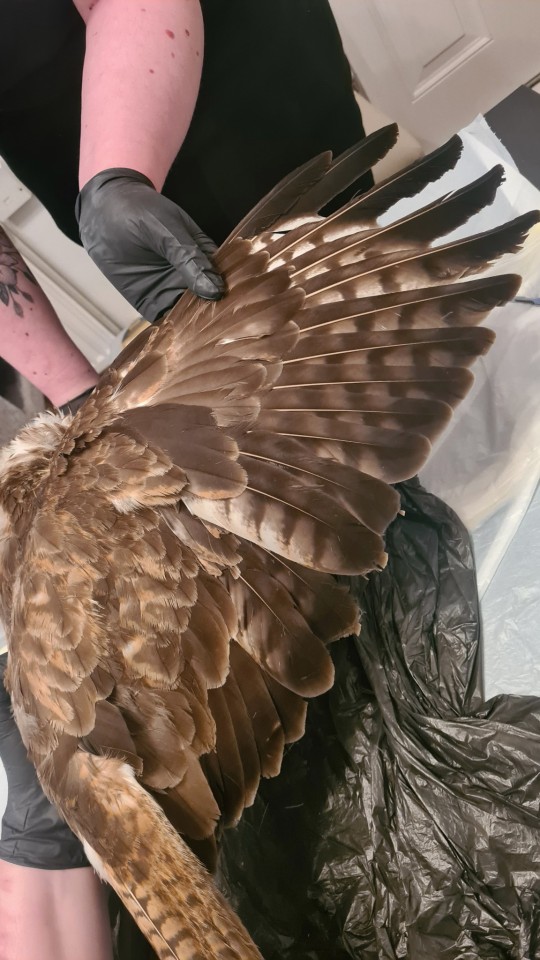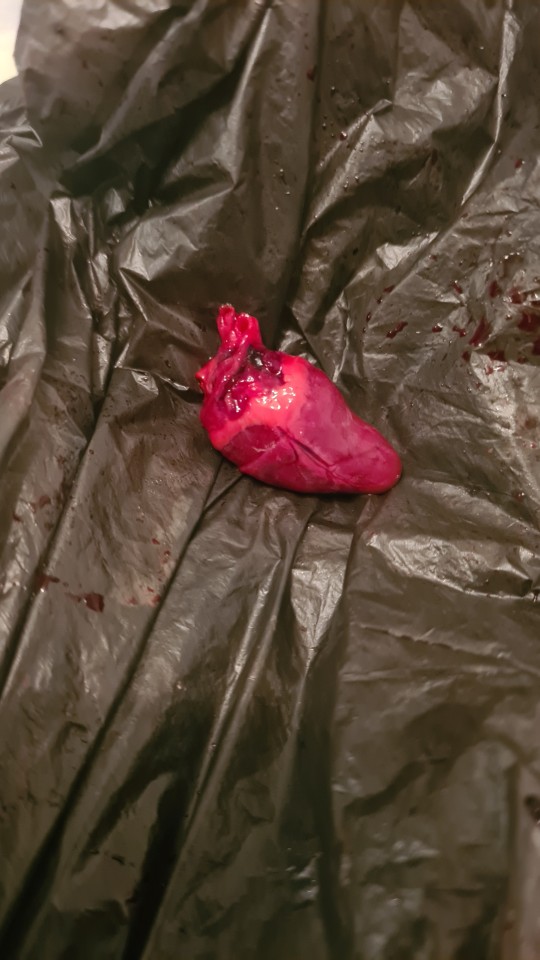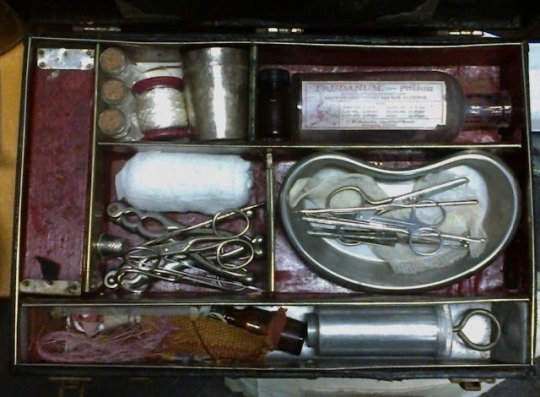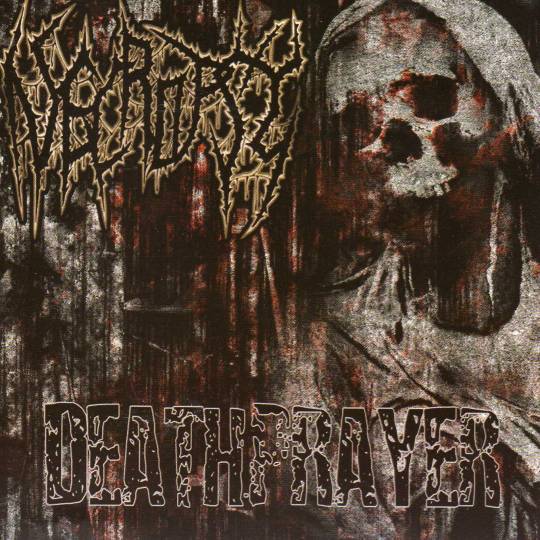#necropsy
Text

equine digestive system (necropsy)
145 notes
·
View notes
Note
A bit morbid, but I'm curious: When a human dies in suspicious circumstances, a forensics expert does an autopsy to look for any evidence of foul play. If an animal dies in suspicious circumstances, are there specialist vets who do the same kinds of checks, or does it fall to general practice vets, or do the human forensics experts handle animals too? (I'm sure the police aren't remotely as interested in investigating animal deaths as they are human deaths, but it must come up occasionally, right?)
Sueanoi here
Veterinary pathology is a thing, and we do Necropsy (like Autopsy but for animals) all the time. It's quite a specialized work. It was a mandatory lesson but I never had performed a necropsy on my own in my career.
I do use their service for Biopsy (same work but the sample came from an animal that is still alive) and other lab works.
Note: it is quite routine for Large animal vets that they would perform necropsy on culled animals so they can evaluate the health of the entire herd.
72 notes
·
View notes
Text
Cw necropsy photos and animal death.
This is my favorite blogger! its a shame they are not on tumblr but this is a necropsy on a 3 year old hen
32 notes
·
View notes
Text






Tagged as Mature due to necropsy photos! This is an educational post, not for shock value.
Prepped the European Buzzard (Buteo buteo) for necropsy, bone processing and feather plating tonight with a PhD Biology Student.
Trauma to the head, neck and ribcage as expected due to being hit by a car. While working through each organ we found huge hemorrhaging with the lungs, as well as a broken wing (left ulna). We also located the testes above the Kidneys which confirmed it was male :)
Also got to show the fascinating tongue with the longitudinal ridges, and backward facing spines to help push down prey into the throat, the little hole in the tongue where increased airflow is passed through, as well as the hyoid structure!
Since the bird was not taxidermy suitable (legs are being used by someone else for a mount), this bird will be part macerated and part oxidated, and the wings plated and framed.
#necropsy#science#vulture culture#vcuk#birds of prey#no mbta uk#my collection#skulls#bones#vulture culture uk#taxidermy#animal skull#oddities#animal skulls#dead things#animal gore#tw gore#processing
39 notes
·
View notes
Text
youtube
NECROPSY-ALL THE GRIEF
3 notes
·
View notes
Note
cant remember if we already sent some or not so even if we did you can answer these too if you please. 33, 41, 13
33.) your personal favorite oddity about yourself?
OUR MANY FACES WE LOVE TO DESIGN AND WEAR, IN CONJUNCTION WITH THAT, OUR UNENDING URGE TO CREATE WHATEVER WE CAN
41.) what are you currently trying to accomplish?
GETTING ENOUGH MONEY TO MOVE.
13.) what was the premise of your last dream?
ANSWERED!
ASK MEME
2 notes
·
View notes
Text
𝔅𝔬𝔫𝔡𝔢𝔡 𝔟𝔶 𝔅𝔩𝔬𝔬𝔡 - 𝔑𝔢𝔠𝔯𝔬𝔭𝔰𝔶
#Bonded by Blood#Feed the Beast#Necropsy#Release date:#May 12th#2008#Full-length#Genre:#Thrash Metal#Themes:#Insanity#Death#Violence#Society#Science fiction#USA
4 notes
·
View notes
Text
I read this article this week and I wanted to share it because I feel very strongly about the value of pathology as a profession and the struggles the profession as a whole and individual pathologists face. I also believe that autopsy/necropsy is a vital part of what we do as pathologists. As a warning, this post includes discussion of death, disease, and dissection of dead bodies. None of it is graphic, but make the best choice for yourself. These are also my opinions, and I don't know everything, so do with that what you will. This is going to be a long one, so my thoughts are all under the cut…
Two disclaimers: The letter linked above is a response to a previous editorial. Both are written by pathologists. Both are clearly written from a place of deep caring about pathology and a drive to see more medical professionals take up this vital specialty. I have deliberately chosen to link the rebuttal letter and not the original editorial because I feel very strongly that the editorial makes some controversial (and, in my mind, harmful) assertions about autopsy and as such it should not be read without the response. But I do think that there is value in reading both. Secondly, I am writing this from my perspective as a veterinary pathology resident. There are differences between human and veterinary pathology in how we are trained, the role we play in the health of our patients and the public, and what our day to day jobs look like. With this in mind, some of the misconceptions about pathology discussed in these pieces resonated with me, which is why I wanted to share my thoughts, and hopefully get some of you thinking about the same things.
I’m going to pull some key points and quotes from the articles to discuss but again, I highly recommend reading both pieces for yourself. This might be a long one folks, so settle in.
”There is a lack of understanding of our specialty among medical school classmates and eventual colleagues”
I 100% agree. Most of my classmates have next to no idea what I do with my day, or why I care so much about pathology. And this is reflected in the submissions I receive as well. I believe that a large part of why I receive so many cases with insufficient history or inappropriate samples for what the clinician needs. While I recognize that there is not the time in veterinary school to teach every element of every specialty (and I also have a lot of thoughts about the way we currently approach veterinary education in general), vet students get a much more “real-life” experience of the clinical specialties than they do of pathology. The clinical year pathology rotations at the school where I trained and the one where I now work and teach focus entirely on necropsy which, while extremely valuable in its own right, is only a very small proportion of what pathologists do on a daily basis. There are many pathologists who don’t do any necropsies in their role, and we do a disservice to all students by not accurately demonstrating what a pathologist actually does. For veterinarians, necropsy and sample collection are the only skills an anatomic pathologist might use that may also be used in the clinic. But in the same way that I benefit from understanding how the surgery which produces the sample I analyse is performed, I believe there is benefit in clinicians knowing the basics of what happens to that sample when it reaches the lab to generate the report they read.
“Pathology? Don’t you want to be a real doctor?”
This one… oof. I have so many thoughts because I have heard this so many times myself. I’ve been planning a separate post on this point alone, and some of those thoughts are in the point above, but I want to emphasize that pathologists are real doctors. Pathologists are essential to medical practice. We are expert diagnosticians, and that skill is vital to how doctors in other specialties function.
“An autopsy is not healthcare in any form”
The women of the response do an excellent job of rebutting this point, but I would like to emphasize how deeply I disagree with this. Autopsy is closure for a family. Autopsy is the last chance of a person or an animal to tell the story of what happened to them. Autopsy is education, autopsy is our protection against malpractice, autopsy is progress and solutions and knowledge. On the veterinary side, the necropsy of one animal can save the rest of the herd. Imaging can do a lot, but it is no substitute for holding an organ in your hand and being able to look at any piece of it under the microscope. Only necropsy can give you that.
This statement also feeds directly into the misconception that pathologists are not doctors because we do not directly “fix” anything. Diagnosis is essential and more emphasis on how what we do as pathologists influences treatment decisions would help in improving the perception of pathology held by the rest of the medical and veterinary professions.
“All physicians perform a prolonged autopsy during their freshman medical school anatomy class”
Prosection to learn anatomy is not autopsy/necropsy. The function and approach is different, and this is not an accurate representation of either the practice and intention of a true autopsy. The prosections performed by junior med and vet students are there to teach anatomy – the process is drawn out, performed on preserved cadavers, and focusses on minute detail. Autopsy/necropsy is a medical examination. There are specific questions to answer, and the approach is designed to fill that purpose. A student who has only experienced anatomy prosection has no true understanding of autopsy. The do not understand the care, the intention, the science of a necropsy performed by a pathologist. And the suggestion that anatomy dissection could or should be the only experience our medical and veterinary students have of autopsy/necropsy will only lead the profession further from a true understanding of what it is pathologists do and why we value necropsy so highly.
“The dismembering nature of the practice”… “It is dirty, malodorous, and dangerous. It carries infection risks for pathologists”
This is a medical exam, not dismemberment. Aspects of necropsy can be dirty, malodorous, dangerous, and carry an infection risk, but so does surgery. So does palliative care. So does pediatric medicine and large animal medicine and laboratory work. As medical professionals we cannot shy away from what is unpleasant to the detriment of the dignity and care of our patients and the progress of our science and our professions. Necropsy is not always a pleasant process, and not everyone will want to perform them, that is true. However, I personally found surgery distasteful and unpleasant, that does not mean I think we should stop performing it. With the appropriate safety measures in place, necropsy does not pose a significantly greater risk to those performing it than any other medical procedure. However, this is a reason why physicians and veterinarians should be the ones performing autopsies/necropsies, not lay people or unsupervised technicians. Our training in the recognition of disease allows us the unique capacity to read a history and quickly identify those cases that pose a greater risk, and require more specific PPE or safety measures. SOPs can help, but no checklist or protocol can outweigh deep medical knowledge for assessing and mitigating the risks of exposure to cadavers.
“Those rare physicians who want to perform autopsies can undertake a forensics fellowship – but, again, why must they be pathologists?”
Pathologists have the depth of understanding of how disease progresses and how gross and histologic changes correlate which is vital for interpreting the nuance and inter-relationships of the various changes you can see in a single body. No other professional is adequately prepared to interpret these findings, and it devalues the practice of autopsy to imply that this is merely a sample collection and recording exercise.
Overall, I strongly believe that autopsy/necropsy has intrinsic value to the practice of medicine, and should continue to be a part of the training of not just pathologists, but every medical and veterinary student. The path to improving the perception of pathologists and the work we do is not through eliminating anything which makes people uncomfortable, but through providing better education so that the purpose of what we do, and how it helps and supports the practice of medicine in every specialty is better understood by our non-pathologist colleagues. Pathologists deserve respect, and denigrating what we do from inside the profession does nothing but detract from that. What we do is valuable. What we do is vital. And we need to help others see that.
#pathology#necropsy#autopsy#tw death#tw disease#tw dissection#vetblr#pathblr#veterinary pathology#vet path#lizziedoesvetpath#lizziedoespathology
81 notes
·
View notes
Video
youtube
Necropsy - Go All the Way of Flesh (1992)
1. Born and Begotten in Sin
2. Dance Among the Dead
3. Cross of Deceased Flesh
4. Garden of Rotting
3 notes
·
View notes
Text
художественная медицина

1 note
·
View note
Text
unfriendly reminder that singlets have no place in syscourse and i personally think it's fucking weird if you aren't a system and you list your stances on syscourse topics in your pinned post? not fucking cool. i don't care how controversial the topic is, if it doesn't directly affect you then fucking zip it. thanks.
you also do not get a say in whether or not endos are systems! it's fair enough to say your blog is endo-safe but you don't get a single vote in whether or not they are considered systems or if they should be included in our community because it doesn't fucking affect you!!
58 notes
·
View notes
Text
so, you guys knew there was an incident where a bald eagle happened to be floating dead in a lake beside the body of a loon chick? And how the necropsy revealed the eagle was killed by being stabbed through the heart by an adult loon’s beak?? 🦅 ♥️
Yeah, that made me think of Dick after Jason’s death.
#feral dick killing the joker#owl song#maybe#would fit I guess#so how do I turn this into poetry for art#btw I lived through surgery#anesthesia was a B*** to come out of tho#I can assure you now tho that every fic dealing with confused people after they wake up is real tho#Jason todd#dick Grayson#Nightwing#Robin#joker#necropsy of a bald eagle#loon chicks and eagles#Jason and dick#talon dick grayson#court of owls
89 notes
·
View notes
Text

Detection of mad cow disease (bovine spongiform encephalopathy) involves the severance of the head and the extraction of part of the brain near its base during necropsy. The tissue will then be tested for the presence of the disease-causing prion <3
#i found this picture so interesting#and i've witnessed this being done in a necropsy before#agriculture#sorry i just wanted to make at least one ag post
16 notes
·
View notes
Text
maaaaaan! Sarge died :(( he was fine this morning, then just now went down and he was gone... parameters are ok so idk, it could've been classic random betta death. (i do have a weird theory after looking at his body but it's so hard to know...)
I'm just so sad...i made him his beautiful 10g and he never ever got to live in it. swim in peace little dude i wish I'd known you longer :'(

#ok weird theory is yucky so don't read if you're squeamish#his tank has a ton of string algae. i found his body tangled up in it#like he'd died at the surface and floated down into a mess of algae#his fins were slightly eaten by snails but body completely intact. nothing weird on body.#the weirdness... was his eye 😬#one eye was pulled out of his head and wrapped in algae almost like a lasso#i wonder if he somehow..??? caught his eye in some algae and died struggling to get out???#I've never in my life heard of a fish getting hurt by algae so maybe not but it was the only thing i found on him out of the ordinary#i always check my dead fish. for the bettas i don't do a full necropsy for parasites since they live alone but i do look them over#maaan.....#once again the intended occupant for the last tank on the betta rack dies 😞 starting to feel haunted#m2a#fish tag
21 notes
·
View notes

